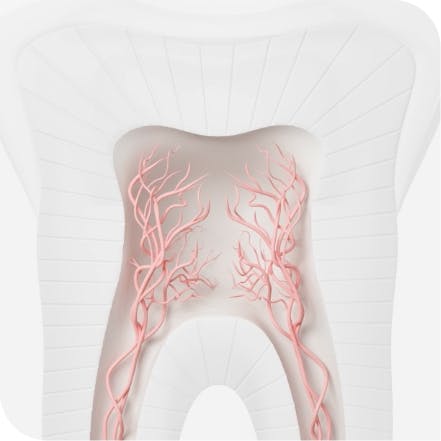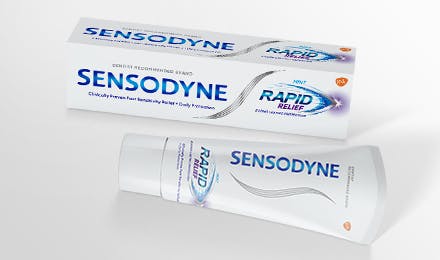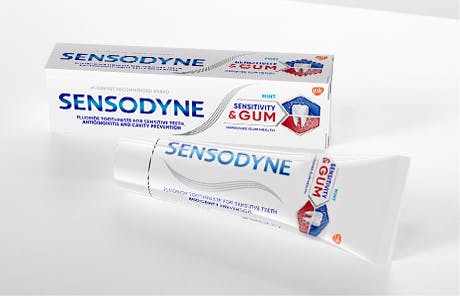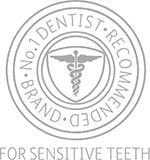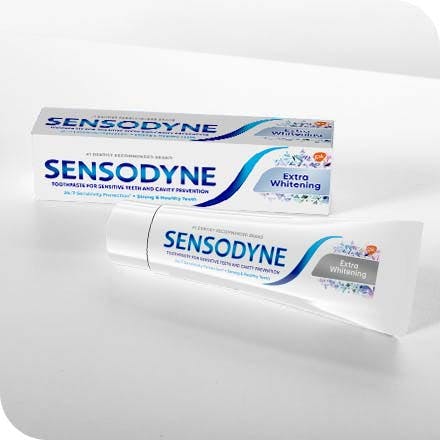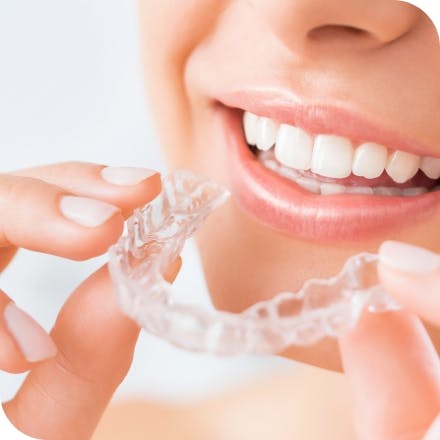Can You Use Whitening Strips on Sensitive Teeth?

Tooth whitening strips are one of the most common over-the-counter ways to achieve a brighter, whiter smile. But for those who have sensitive teeth, whitening strips have the potential to make them feel worse. Fortunately, you can still get a crisp, white smile even if you feel occasional tooth pain from tooth sensitivity.
Symptoms of sensitive teeth
One of the most common tooth complaints, tooth sensitivity, is marked by a rush of pain when you consume food or drink that’s either very cold, or very hot. It’s also known as “dentin hypersensitivity.” Dentin is the layer of the tooth underneath the enamel. It’s made up of tiny tubules, and surrounds a tooth’s delicate nerve endings. In dentin hypersensitivity, a tactile or environmental stimulus of the dentin results in a shift of fluids within the tubules, which activate the nerve endings in the pulp of the tooth.1,4 Sensitive teeth have about eight times the number of tubules than non-sensitive teeth, so a stimulus like cooling, drying, heat, evaporation and chemical stimulus can all lead to an increase in pain.1
When you apply whitening products to your teeth, you are placing bleaching agents onto the outer enamel which then seep down to the dentin. Higher amounts of peroxide (bleaching agents) and increased tooth contact time may trigger more sensitivity pain, which may outweigh the goal of having whiter teeth for some.3
How to use whitening strips
Over-the-counter whitening products are widely available and contain bleaching agents at lower concentrations than one would find in a dental office.5,6 Most whitening strip kits contain peroxide as the main ingredient, such as hydrogen peroxide or carbamide peroxide.5 These ingredients penetrate the enamel layer and reach your teeth’s dentin.3,5 Hydrogen peroxide diffuses easily through the layers of the tooth within minutes of exposure.5
Most whitening strips are applied after you brush your teeth so that the surface is free of debris. They are commonly applied to teeth for a length of time of about 30 minutes at a rate of once or twice a day, though directions may vary by manufacturer.6 The most common kits use hydrogen peroxide at a concentration of 5-14% as their key component, and users are directed to continue to apply the product from 14 days to 6 weeks.4,6 Whitening treatments that contain chlorine dioxide commonly found in "beauty spas, cruise ships, and mall kiosks" have limited studies on safety and may damage enamel and cause sensitivity.2
Can whitening strips cause tooth sensitivity?
One common adverse effect of whitening procedures and products, including whitening strips, is increased tooth sensitivity.5 This may be due to prolonged peroxide exposure causing temporary inflammation of the pulp of your teeth.5,7 Gingival irritation may occur as well if the peroxide gel on the whitening strip comes in contact with your gums.5
While hydrogen peroxide is a powerful ingredient in terms of whitening, it does have some negative local effects on the tissues within the mouth and tooth structures.7 Some reported effects include:3,7
- Dentin hypersensitivity
- Gingival irritation
- Changes in microhardness
- Increased susceptibility to demineralization
- Irritation to the pulp of the teeth
Whitening strips that are not carefully applied and come into contact with your gums may lead to irritation and pain.7
How to safely whiten sensitive teeth
Despite the possibility of sensitivity that may arise when using whitening strips, there are ways for those with sensitive teeth to attain a gleaming white smile. Consider these tips if you’re embarking on a whitening treatment:
- Use whitening strips with lower concentrations of peroxide: Whitening products with high concentrations of hydrogen peroxide may cause sensitivity.3 A 2018 study showed that tooth sensitivity and gum or gingival irritation were more prevalent with higher concentrations of peroxide.5 Some whitening products may contain less peroxide or have specific formulas tailored to sensitive teeth.
- Talk to a professional: In order to minimize any risks, any kind of tooth whitening should be done under the supervision of a dental professional.2 Your dental professional can help you understand what products are available and which are most appropriate for you in order to reduce risks and maximize benefits.3 No matter which products you use, rely on the instructions on the packaging and use the correct dosage as recommended.
- Be aware of stimuli: Consider your own personal triggers for tooth sensitivity. Extreme temperatures which may all contribute to an increase in pain.1 Avoid overly hot coffee or ice cream, for example, during a whitening regimen.
- Use a soft toothbrush: A toothbrush with softer bristles, such as the Sensodyne Sensitive Care Toothbrush, can be helpful for those with sensitive teeth.1 Take time to understand proper brushing technique to ensure that you’re not using too much pressure or excessively scrubbing.1 .
Tooth sensitivity is a common issue and can negatively affect the quality of one’s life in regard to food and oral hygiene.1 If you have tooth sensitivity, use Sensodyne Clinical White Enamel Strengthening and Sensodyne Clinical White Stain Protector toothpastes two weeks before, during, and after your whitening treatment to help care for sensitive teeth and guide you toward a brighter smile, thanks to clinically proven whitening technology specifically designed for sensitive teeth. Sensodyne Clinical White toothpastes are gentle enough for everyday use thanks to low-abrasive whitening technology that helps protect teeth from future stains. For those with sensitive teeth, achieving a whiter smile isn’t impossible, and any sensitivity or irritation that may occur during a whitening process typically resolves shortly after completion of the treatment.5
Of course, consulting your dental professional is a vital step before starting any sort of treatment, especially when coupled with sensitive teeth.
Source Citations:
- Dentin Hypersensitivity: Etiology, Diagnosis and Treatment; A Literature Review. National Library of Medicine. https://www.ncbi.nlm.nih.gov/pmc/articles/PMC3927677/. Accessed 11/17/23.
- Safety issues of tooth whitening using peroxide-based materials. British Dental Journal. https://www.nature.com/articles/sj.bdj.2013.629/. Accessed 6/15/2023.
- Tooth Whitening: What We Now Know. National Library of Medicine. https://www.ncbi.nlm.nih.gov/pmc/articles/PMC4058574/#__ffn_sectitle/. Accessed 6/15/2023.
- Pretty painful: Why does tooth bleaching hurt? National Library of Medicine. https://www.sciencedirect.com/science/article/abs/pii/S0306987709008019?via%3Dihub. Accessed 11/17/23.
- Whitening. American Dental Association. https://www.ada.org/resources/research/science-and-research-institute/oral-health-topics/whitening. Accessed 11/17/23.
- Over-the-Counter Tooth Whitening Agents: A Review of Literature. Brazilian Dental Journal. https://www.scielo.br/j/bdj/a/yjx5CcCCQzRWqhzFKVSgVVK/?lang=en. Accessed 11/17/23.
- Undesirable and adverse effects of tooth-whitening products: a review. Springer. https://link.springer.com/article/10.1007/s00784-009-0302-4. Accessed 11/17/23.
